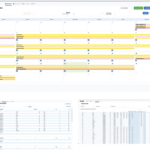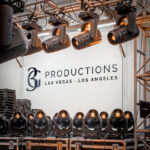True to its name, Blizzard Lighting appears to be taking the world of small and mid-sized lighting design by storm. The Waukesha, WI, company offers more than 100 lighting products (not counting accessories, bags, cables and the like). “We’ve got a really strong base of products,” says founder Will Komassa. “They start at performance and price points that a mobile DJ or local band can use and go all the way up to something that production companies could use on a tour of any size [including KISS’ rig].
“We also have lighting gear for permanent installations in theaters, churches and architecture [including Qualcomm Stadium in San Diego]. We have quite a few different color changers, a number of moving-head configurations, washes, spots, DJ effects, proprietary software, outdoor fixtures, control products, and wireless DMX [digital multiplex for controlling light effects].”
In fact, it was a storm that inspired the firm’s moniker. On a proverbial cold and stormy night in February 2010, Komassa “was sitting in a hot bath thinking about what to call us. It was freezing outside, definitely snowing, and I remember thinking ‘Blizzard…hey, that’s got a cool ring to it and has some edge.’ I tried it out on my business partner Bob Mueller, who liked it, and that’s what we went with.”
 Day Job, Night Gigs
Day Job, Night Gigs
For the preceding five years, Komassa had been working as an attorney at a big accounting firm, doing tax work for people who were on international assignments traveling from country to country. “Believe it or not, I used to really enjoy that stuff. Now the mere thought of it makes me shudder!” While lawyering, he was also in a band called Chapter 2 (with Mueller) that regaled patrons of the Milwaukee area’s seediest bars with covers of songs by Led Zeppelin, Van Halen, the Who and other 70s and 80s rockers. He still prides himself on being able to play the Hammond B-3 solo on Deep Purple’s “Highway Star.”
“We always tried to put on a good show, and lighting and sound are just as important as the group that’s on stage. If you’ve got a dynamite band but nobody can see you, that’s not going to take you real far.” A fan of acts like Pink Floyd and Rush, he was as impressed by their light shows as by their music. He tried to emulate them on Chapter 2’s very limited resources, usually to his band mates’ chagrin.
“I brought all sorts of goofy lights to gigs,” he recalls. “They were big and heavy and second-hand by a couple of generations. It got to the point that the trailer with our gear was three-quarters full of lighting equipment. One of the first big-ticket items I bought were big, 250-watt moving head discharge fixtures that looked great, but they were so heavy you could ballast the Eiffel Tower with them. Everybody else in the band hated moving them around and there was so much DMX cabling, it was like walking in spaghetti.”
Komassa has looked at lights from both sides now, as a technician and as a performer. “I’ve been singing for as long as I can remember,” he says. “In middle school, I was in musicals and would help out with the lighting. We had huge, old, old, old dimmer panels that were basically just gigantic rheostats. They had wood push rods that somebody in shop class had probably made so you could push three or four of them up and down at the same time. Giving 10- or 11-year-old kids the power to control thousands of volts of electricity on hundred-year-old equipment was probably not the safest thing to do! But it got me started.”
In high school, he did musicals, both performing in them and working behind the scenes as the stage manager, a role that included lighting design, programming the console, hanging lights, running cables, “whatever needed to be done.” At the University of Wisconsin in Madison, he became the technical director of a traveling troupe called the Wisconsin Singers, for whom he ran the live sound, did the lighting design and all the building and fixing required to keep a show group on the road for 40 shows a year. Though his major was broadcast journalism, he also took classes in lighting and scenic design in the theater department, absorbing ideas and knowledge from MFA students and noted experts in the field like Linda Essig and Ken Billington. He also served as the UW Theater’s master electrician for several seasons.
 A New Opportunity
A New Opportunity
In one of those silver-lining moments, Komassa was let go from the accounting firm when it laid off all of its attorneys.
“While I was looking around for a new ‘normal person’ job, I started tinkering around with LED lights and trying them out in the band. I slowly began selling them, losing money at first, then gradually developing some marketing for them.” The rest is, as they say, Blizzard Lighting.
“We first operated out of my house, which required some creativity from a logistics standpoint. Bob and I worked in the basement. Product shipments would be delivered to the garage upstairs. We put a 12-foot shelf that I had liberated from a closet down on the stairs and would slide arriving packages down that plank into the basement. There we opened the boxes, tested every single light, prepared orders for customers and lugged it all back upstairs for shipping out.”
The nascent company quickly outgrew its home base and leased its first space in 2011. By May of that year, it had sold its first million dollars’ worth of product. The feeling that this might just be a flash in the pan began to fade and the company brought on Frank Luppino, whom Komassa calls “the world’s nicest, most lovable sales dork,” as director of sales. “He’s been in this industry for a long time, knows everyone, and has done a ton to help us,” said Komassa. “Sales started piling up and we began adding new products.”
Within months, Blizzard relocated to a still larger facility, where it roosted for a little less than two years. In March 2013, it settled into its current 10,000-square-foot location, where in November it passed the five-million-dollar mark. “We’re already busting out at the seams again, which is kind of nerve-wracking but cool at the same time.”
 An End-User Perspective
An End-User Perspective
An overriding mission at the lighting company is to enable a producer of small or mid-sized shows to get big-dollar effects on a small-dollar budget. How do they accomplish that?
“We do research on designs that OEMs (original equipment manufacturers), particularly overseas, are making to find things that fit into our product line,” Komassa explains. “For example, for the very first fixture that we ever did, I started talking to an OEM in China about a very small, moving-head spot with a single LED that was getting popular. It was a great idea, but in practice, it just did not have very much power. I convinced them to take the same fixture and make it a wash by putting a lot more LEDs in it. Without the optics needed to focus a spot, beam, it could take the extra LEDs and have a lot more impact in a small space. That’s been the model for what we do for every product we have—research, development, testing, breaking, putting back together, etc. It’s a lot of fun and also can be challenging. You’ll think you have something just right and someone will say, ‘Well, what about this?’ and back you go to the drawing board.”
At the LDI 2013, Blizzard debuted a new moving-head spot. Instead of generating colors by passing white light through dichroic color filters and getting eight or ten colors, it can make virtually any color by using color-changing LEDs at the brightness of a 350-watt discharge fixture for a lot less cost per output.
LED Advantages
Komassa considers LEDs the greatest thing to happen to lighting since the light bulb. “They’re so perfectly suited to stage lighting,” he says, “because they’re small and can take abuse. They use a lot less power, generate a lot less heat, can create an infinite number of colors and adapt to different environments. And like every good innovation, a million ideas come from it, so you’re seeing lighting components that have replaced traditional incandescent or discharge fixtures and in shapes and sizes you’ve never seen before. They operate at up to 80 percent power savings, are extremely reliable and last practically forever.”
One innovation from Blizzard’s wizards is the Puck, a PAR can that resembles an oversized version of the familiar hockey disk. (The term PAR can refers to a can-shaped Parabolic Aluminized Reflector wash light that, since the advent of LEDs, tends not to be parabolic, aluminized or can-shaped.) It lays flat, needs no mounting brackets, and is used by mobile DJs and entertainers for room up-lighting. Its LEDs can be color-coordinated to match an event’s theme, e.g., bridesmaids’ dresses, holidays.
Blizzard’s dealer network, which began with one local music store in Milwaukee, now numbers about 400 dealers around the country, including large and small music stores, online retailers, specialty shops, etc. The company has garnered glowing feedback from customers. One of them, Michael Jurken, president of Wisconsin-based production house Majic Productions, concurs: “We’ve been Blizzard dealers for more three years, with hundreds of their lighting fixtures in our rental inventory. They are light years ahead of their competitors, with customer service that is second to none. They have an incredible culture that carries over into their brand. What sets them apart is their willingness to communicate with their customers to find out what they need and develop products based on these needs.”
“Another thing that distinguishes us from our competitors,” says Komassa, “is our sense of humor (check out the company’s mini-Stonehenge-with-tiny-lights project on video). We try to have fun with what we’re doing, and I think that resonates with our clients. Since we’re smaller, we tend to have an edge in speed, price, quality and agility. We do everything in our power and far more than most to keep our customers happy and coming back. I think our reputation is one of quality, being innovative and delivering a lot of product for a low price. We stand behind our products, making sure they’re the right fit for the customers and helping them learn how to use them well. I’m very, very pleased and proud to be part of building this company and being able to support our employees and their families.”
For more information, go to www.blizzardlighting.com


